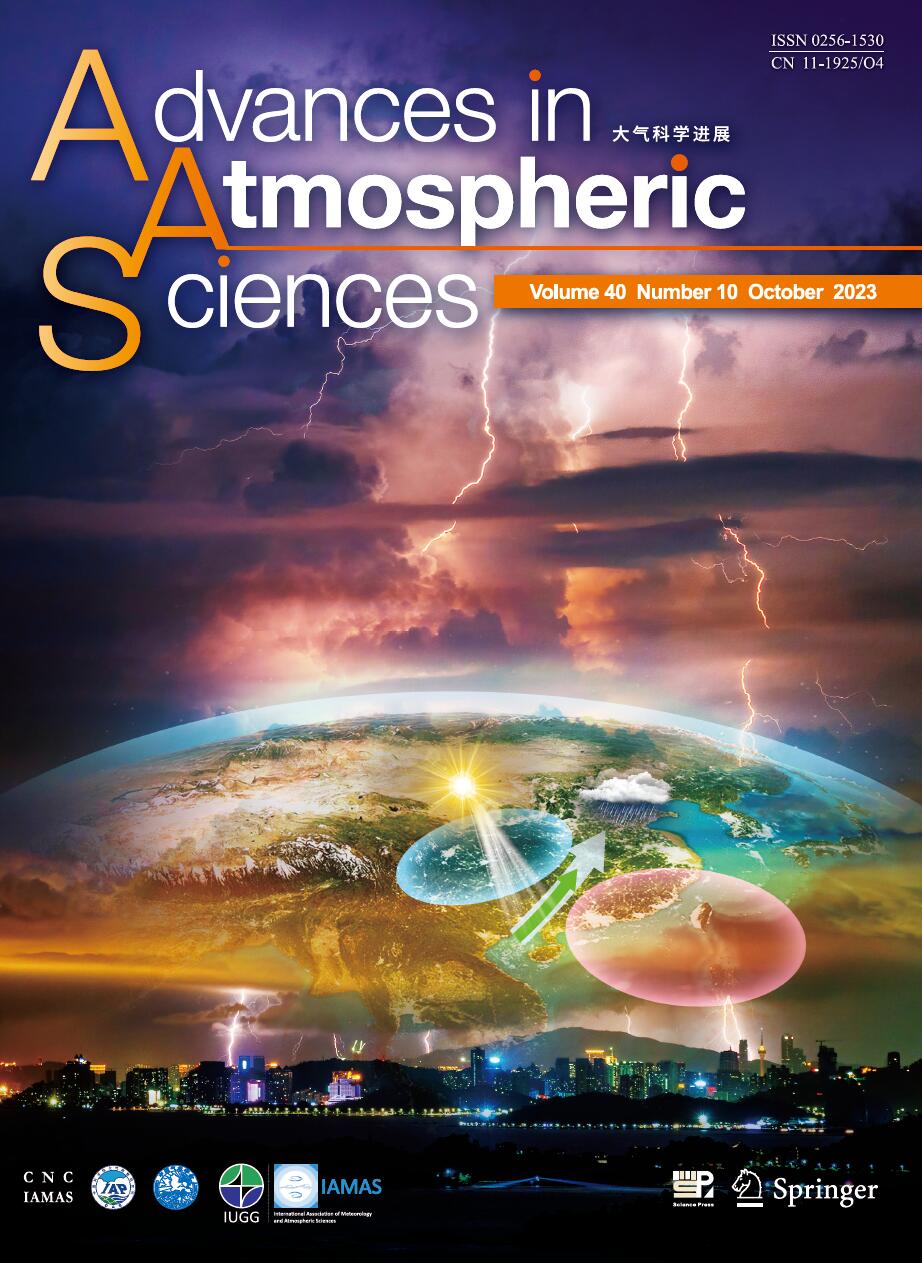| [1] |
Sijia LI, Yuan WANG, Huiling YUAN, Jinjie SONG, Xin XU,
2016: Ensemble Mean Forecast Skill and Applications with the T213 Ensemble Prediction System, ADVANCES IN ATMOSPHERIC SCIENCES, 33, 1297-1305.
doi: 10.1007/s00376-016-6155-2
|
| [2] |
Zheng HE, Pangchi HSU, Xiangwen LIU, Tongwen WU, Yingxia GAO,
2019: Factors Limiting the Forecast Skill of the Boreal Summer Intraseasonal Oscillation in a Subseasonal-to-Seasonal Model, ADVANCES IN ATMOSPHERIC SCIENCES, 36, 104-118.
doi: 10.1007/s00376-018-7242-3
|
| [3] |
Jing Ma, Haiming Xu, Changming Dong, Jingjia Luo,
2023: Forecast Skills and Predictability Source of the Marine Heatwaves in the NUIST-CFS1.0 Hindcasts, ADVANCES IN ATMOSPHERIC SCIENCES.
doi: 10.1007/s00376-023-3139-x
|
| [4] |
Gill M. MARTIN, Nick J. DUNSTONE, Adam A. SCAIFE, Philip E. BETT,
2020: Predicting June Mean Rainfall in the Middle/Lower Yangtze River Basin, ADVANCES IN ATMOSPHERIC SCIENCES, 37, 29-41.
doi: 10.1007/s00376-019-9051-8
|
| [5] |
LIU Xiangwen, WU Tongwen, YANG Song, JIE Weihua, NIE Suping, LI Qiaoping, CHENG Yanjie, LIANG Xiaoyun,
2015: Performance of the Seasonal Forecasting of the Asian Summer Monsoon by BCC_CSM1.1(m), ADVANCES IN ATMOSPHERIC SCIENCES, 32, 1156-1172.
doi: 10.1007/s00376-015-4194-8
|
| [6] |
JIANG Zhina, MU Mu,
2009: A Comparison Study of the Methods of Conditional Nonlinear Optimal Perturbations and Singular Vectors in Ensemble Prediction, ADVANCES IN ATMOSPHERIC SCIENCES, 26, 465-470.
doi: 10.1007/s00376-009-0465-6
|
| [7] |
Hui-Wen LAI, Fuqing ZHANG, Eugene E. CLOTHIAUX, David R. STAUFFER, Brian J. GAUDET, Johannes VERLINDE, Deliang CHEN,
2020: Modeling Arctic Boundary Layer Cloud Streets at Grey-zone Resolutions, ADVANCES IN ATMOSPHERIC SCIENCES, 37, 42-56.
doi: 10.1007/s00376-019-9105-y
|
| [8] |
Liu Yangang,
1995: On the Generalized Theory of Atmospheric Particle Systems, ADVANCES IN ATMOSPHERIC SCIENCES, 12, 419-438.
doi: 10.1007/BF02657003
|
| [9] |
Masoud NOBAKHT, Bahram SAGHAFIAN, Saleh AMINYAVARI,
2021: Skill Assessment of Copernicus Climate Change Service Seasonal Ensemble Precipitation Forecasts over Iran, ADVANCES IN ATMOSPHERIC SCIENCES, 38, 504-521.
doi: 10.1007/s00376-020-0025-7
|
| [10] |
Daquan ZHANG, Lijuan CHEN, Gill M. MARTIN, Zongjian KE,
2023: Seasonal Prediction Skill and Biases in GloSea5 Relating to the East Asia Winter Monsoon, ADVANCES IN ATMOSPHERIC SCIENCES, 40, 2013-2028.
doi: 10.1007/s00376-023-2258-8
|
| [11] |
Li Guoping, Duan Tingyang, Wan Jun, Gong Yuanfa, Shigenori Haginoya, Chen Longxun, Li Weiliang,
1996: Determination of the Drag Coefficient over the Tibetan Plateau, ADVANCES IN ATMOSPHERIC SCIENCES, 13, 511-518.
doi: 10.1007/BF03342041
|
| [12] |
Zhe-Min TAN, Lili LEI, Yuqing WANG, Yinglong XU, Yi ZHANG,
2022: Typhoon Track, Intensity, and Structure: From Theory to Prediction, ADVANCES IN ATMOSPHERIC SCIENCES, 39, 1789-1799.
doi: 10.1007/s00376-022-2212-1
|
| [13] |
Gu Wei, Wu Rongsheng,
1992: The Theory Study of the Influence of the Topography on the Cold Frontal Motion, ADVANCES IN ATMOSPHERIC SCIENCES, 9, 167-172.
doi: 10.1007/BF02657507
|
| [14] |
Jiehong XIE, Jinhua YU, Haishan CHEN, Pang-Chi HSU,
2020: Sources of Subseasonal Prediction Skill for Heatwaves over the Yangtze River Basin Revealed from Three S2S Models, ADVANCES IN ATMOSPHERIC SCIENCES, 37, 1435-1450.
doi: 10.1007/s00376-020-0144-1
|
| [15] |
Zhao Yanzeng, Hu Yuliang, Zhao Hongjie,
1984: INTEGRATION METHOD AND RATIO METHOD FOR RETRIEVING EXTINCTION COEFFICIENT FROM LIDAR SIGNALS, ADVANCES IN ATMOSPHERIC SCIENCES, 1, 53-75.
doi: 10.1007/BF03187616
|
| [16] |
Xiaojuan SUN, Siyan LI, Julian X. L WANG, Panxing WANG, Dong GUO,
2022: A New Method of Significance Testing for Correlation-Coefficient Fields and Its Application, ADVANCES IN ATMOSPHERIC SCIENCES, 39, 529-535.
doi: 10.1007/s00376-021-1196-6
|
| [17] |
Yu Rucong, Zhang Minghua, Yu Yongqiang, Liu Yimin,
2001: Summer Monsoon Rainfalls over Mid-Eastern China Lagged Correlated with Global SSTs, ADVANCES IN ATMOSPHERIC SCIENCES, 18, 179-196.
doi: 10.1007/s00376-001-0012-6
|
| [18] |
Ting WANG, Jianfang FEI, Xiaoping CHENG, Xiaogang HUANG, Jian ZHONG,
2018: Estimating the Correlated Observation-Error Characteristics of the Chinese FengYun Microwave Temperature Sounder and Microwave Humidity Sounder, ADVANCES IN ATMOSPHERIC SCIENCES, 35, 1428-1441.
doi: 10.1007/s00376-018-8014-9
|
| [19] |
Guokun DAI, Mu MU, Zhina JIANG,
2019: Evaluation of the Forecast Performance for North Atlantic Oscillation Onset, ADVANCES IN ATMOSPHERIC SCIENCES, , 753-765.
doi: 10.1007/s00376-019-8277-9
|
| [20] |
ZHU Jiang, LIN Caiyan, WANG Zifa,
2009: Dust Storm Ensemble Forecast Experiments in East Asia, ADVANCES IN ATMOSPHERIC SCIENCES, 26, 1053-1070.
doi: 10.1007/s00376-009-8218-0
|















 AAS Website
AAS Website 
 AAS WeChat
AAS WeChat 
 DownLoad:
DownLoad: